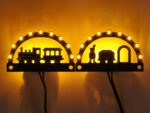UNCOUPLER: LGB 2x43x Ge 4/4 II
The Ge 4/4 II of LGB has to be adapted for the automatic decoupler only slightly. On both bogies, 15 mm must be cut off from the double plastic web. The automatic decoupler ensures safe operation. Here the changes for installation in a Ge 4/4 II 2x43x Milled coupling holder Fully assembled decoupler


 Deutsch
Deutsch


